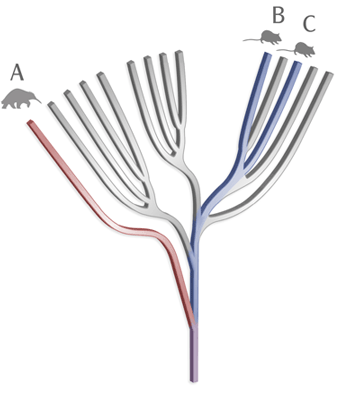EDGE species

Evolutionarily Distinct and Globally Endangered (EDGE) species represent a disproportionate amount of unique evolutionary history. They have few close relatives, are often the only surviving member of their genus, and sometimes the last surviving genus of their evolutionary family. Some EDGE species, such as elephants and pandas, are well known and already receive considerable conservation attention, but many others, such as the Vaquita (the world’s rarest cetacean)[1] the bumblebee bat (arguably the world’s smallest mammal) and the egg-laying long-beaked echidnas are highly threatened yet remain poorly understood and are frequently overlooked by existing conservation frameworks. Recent research indicates that 70% of the world’s most threatened and evolutionarily distinct mammal species are currently receiving little or no conservation attention.[2] If these species are not highlighted and conserved we will not only lose many of the world’s unique species and a disproportionate amount of biodiversity, but we may also greatly reduce the potential for future evolution. The Zoological Society of London (ZSL) has launched a new global conservation initiative, the EDGE of Existence Programme to raise awareness and funds for the conservation of these species.
Calculating EDGE Scores

Every species is given a score according to the amount of unique evolutionary history it represents, and its conservation status. These scores are used to identify EDGE species.
Some species are more distinct than others because they represent a larger amount of unique evolution. Species like the aardvark have few close relatives and have been evolving independently for many millions of years. Others like the domestic dog originated only recently and have many close relatives. Species uniqueness’ can be measured as an 'Evolutionary Distinctiveness' (ED) score, using a phylogeny, or evolutionary tree.
In the phylogeny shown on the right, species A has a higher ED score than either species B or C - it represents a branch rather than a twig on the tree of life. If species A were to go extinct, there would be no similar species left on the planet and a disproportionate amount of unique evolutionary history would be lost forever.
Globally Endangered (GE) scores for each species are measured according to the IUCN Red List of Threatened Species, an assessment of the conservation status of the world's plant and animal species.

Summary of 2006 IUCN Red List categories.
Species which are Critically Endangered receive a higher score than less threatened species, which in turn, receive a higher score than those not currently in danger of extinction.
The two scores are then combined to produce an overall EDGE score for each species:
This means that a doubling in ED affects the EDGE score almost as much as increasing the threat level by one (e.g. from Vulnerable to Endangered). EDGE scores are an estimate of the expected loss of evolutionary history per unit time.
EDGE species are species which have an above average ED score and are threatened with extinction (Critically Endangered, Endangered or Vulnerable). There are currently 564 EDGE mammal species (≈12% of the total). Potential EDGE species are those with high ED scores but whose conservation status is unclear.
Focal species
Many EDGE species are not being adequately protected by existing conservation measures. This suggests that a disproportionate amount of evolutionary history is likely to be lost in the near future. To redress this balance, ten focal species are selected each year for which active research and conservation programmes will be carried out.
The focal species are the subject of research programmes aimed at establishing what the main threats are and what actions need to be taken to ensure their survival. Each study is focused on delivering a conservation action plan. These plans provide information on the conservation actions highlighted by the research programme, and identify key stakeholders that will carry out these actions.
2007/8 focal mammal species
Numbers refer to EDGE rank
- 1. Yangtze River dolphin (Lipotes vexillifer)
- 2. Attenborough’s long-beaked echidna (Zaglossus attenboroughi)
- 5. Hispaniolan solenodon (Solenodon paradoxus)
- 8. Bactrian camel (Camelus bactrianus)
- 21. Pygmy hippopotamus (Hexaprotodon liberiensis)
- 22. Slender loris (Loris tardigradus)
- 37. Hirola antelope (Beatragus hunteri)
- 46. Golden-rumped elephant-shrew (Rhynchocyon chrysopygus)
- 49. Bumblebee bat (Craseonycteris thonglongyai)
- 81. Long-eared jerboa (Euchoreutes naso)
2008/9 focal amphibian species
- 2. Chinese giant salamander (Andrias davidianus)
- 3. Sagalla caecilian (Boulengerula niedeni)
- 4. Purple frog (Nasikabatrachus sahyadrensis)
- 15. Ghost frogs (Heleophryne hewitti and Heleophryne rosei)
- 18. Olm (Proteus anguinus)
- 24. Lungless Mexican salamanders (20 species from the top ranked 100 species, including Parvimolge townsendi, Chiropterotriton lavae, Chiropterotriton magnipes and Chiropterotriton mosaueri)
- 37. Malagasy rainbow frog (Scaphiophryne gottlebei)
- 45. Chile Darwin's frog (Rhinoderma rufum)
- 55. Betic midwife toad (Alytes dickhilleni)
- 69. Seychelles frogs (Sooglossus gardineri, Sooglossus pipilodryas, Sooglossus sechellensis and Sooglossus thomasseti)
See also
References
- ↑ Gulf of California Harbor Porpoise/ Vaquita/ Cochito/ (Phocoena sinus). (2012). National Oceanographic and Atmospheric Administration Office of Protected Resources.
- ↑ Isaac, N. J. B.; Turvey, S. T.; Collen, B.; Waterman, C. (2007). "Mammals on the EDGE: conservation priorities based on threat and phylogeny". PLoS ONE. 2 (3): e296. PMC 1808424
 . PMID 17375184. doi:10.1371/journal.pone.0000296.
. PMID 17375184. doi:10.1371/journal.pone.0000296.